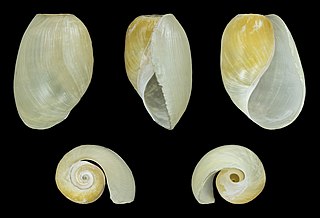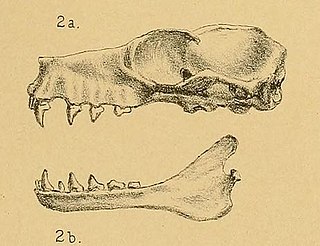Related Research Articles

Mesotardigrada is one of three classes of tardigrades, consisting of a single species, Thermozodium esakii. The animal reportedly has six claws of equal length at each foot. This species was described in 1937 by German zoologist Gilbert Rahm from a hot spring near Nagasaki, Japan. The inability of taxonomists to replicate Rahm's finding has cast doubt on the accuracy of the description, making T. esakii, and by extension the entire class Mesotardigrada, a taxon inquirendum.
The Zoological Record (ZR) is an electronic index of zoological literature that also serves as the unofficial register of scientific names in zoology.

Epomophorus is a genus of bat in the family Pteropodidae. They have a distribution throughout Africa.

Nyctimene is a genus of bats in the Pteropodidae family. Commonly known as tube-nosed fruit bats, they are found in the central Philippines, eastern Indonesia, Papua New Guinea and the north-east coast of Australia.
Eprhopalotus is a genus of hymenopteran insects of the family Eulophidae. Their distribution varies between species but ranges from Costa Rica, Mexico to Texas. There are currently 5 species of Eprhopalotus:
Aacocrinus is a genus of extinct sea lily from the Actinocrinitidae family. There are currently 14 species within this genus:

Aades is a genus of beetles in the family Curculionidae, commonly known as weevils. These insects are found in various parts of the world, including North and South America, Asia, and Europe. They are generally small in size, with most species measuring between 2 and 7 millimeters in length.

Akera bullata, named the royal flush sea slug, is a species of sea snail, a marine opisthobranch gastropod mollusk in the family Akeridae, a family that is related to the sea hares. This species is the only European representative of the genus Akera.
Aagaardia is a genus of fly in the Chironomidae family. Aagaardia has been found in Finland, the mainland of Norway and Russia.
Aglaocrinus is an extinct species of crinoids in the Cladia order. It has been proposed that it was a blind, stationary (attached) suspension feeder the hard parts of which were composed of magnesium calcite. It has been discovered in 3 locations in North America.

Anagyrus is a large genus of parasitic wasps from the family Encyrtidae. Anagyrus is distributed throughout the world. A subgenus of Anagyrus is known as Nesoanagyrus
Chodsigoa is a genus of shrews in the tribe Nectogalini.

Van Sung's shrew, also known as Cao Van Sung mountain shrew is a species of shrew in the Soricomorpha order. Specimens of Chodsigoa caovansunga have been found in Vietnam.

The lesser Taiwanese shrew is a rare species of shrew in the Soricomorpha order.

The Katanglad shrew-mouse, also known as the Kitanglad shrew-mouse is a species of rodent in the family Muridae. It is known only from one specimen taken at 2250 m on Mount Kitanglad, Bukidnon Province, Philippines.
Episoriculus is a genus of shrew in the red-toothed shrew subfamily. Its common is brown-toothed shrew. It has been described as a subgenus to Soriculus in the past. The genus occurs at a number of locations in Asia, including Nepal and China.

The minor epauletted fruit bat is a species of megabat in the family Pteropodidae. It is found in Zambia, Tanzania, Mozambique and Kenya.
Aaka is a genus of hemiptera in the leafhopper family. There is only one species described in this genus, known as Aaka coera. It is distributed in Papua New Guinea.
Aalatettix is a genus of groundhopper, in the family Tetrigidae, with species found in southern China.
The Index to Organism Names (ION) is an extensive compendium of scientific names of taxa at all ranks in the field of zoology, compiled from the Zoological Record by its operators as a publicly accessible internet resource. Initially developed by BIOSIS, its ownership then passed to Thomson Reuters and is currently with Clarivate Analytics.
References
- ↑ peters, shanan. "Sepkoski Online Results". strata.geology.wisc.edu. Retrieved 20 July 2018.
- 1 2 "Archived copy". Archived from the original on 2011-06-13. Retrieved 2010-03-24.
{{cite web}}: CS1 maint: archived copy as title (link) - 1 2 Analytics, Clarivate. "ION: Index to Organism Names". www.organismnames.com. Retrieved 20 July 2018.
- 1 2 "The Paleobiology Database". Archived from the original on 2010-03-06. Retrieved 2010-03-03.
- ↑ "Opinions from J. J. Sepkoski 2002". paleodb.org. Retrieved 2022-09-29.
- ↑ "The Paleobiology Database". Archived from the original on 2007-10-30. Retrieved 2010-03-24.
- ↑ New crinoids from the Naco Formation (middle Pennsylvanian) of Arizona and a revision of the family Cromyocrinidae. Journal of Paleontology, 55(6) 1981: 1176-1199. [Zoological Record Volume 118]
- ↑ "Namebank Record Detail". www.ubio.org. Retrieved 20 July 2018.
- ↑ Reference no: 9940 [ permanent dead link ]
- ↑ Pennsylvanian crinoids of New Mexico. New Mexico Geology, 28(1), February 2006: 3-37. [Zoological Record Volume 143]
- ↑ Analytics, Clarivate. "ION: Index to Organism Names". www.organismnames.com. Retrieved 20 July 2018.
- ↑ "Namebank Record Detail". www.ubio.org. Retrieved 20 July 2018.
- ↑ "Namebank Record Detail". www.ubio.org. Retrieved 20 July 2018.
- ↑ "ION: Index to Organism Names". www.organismnames.com. Archived from the original on 20 July 2018. Retrieved 22 May 2022.